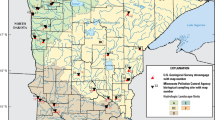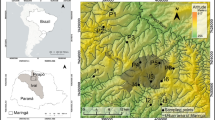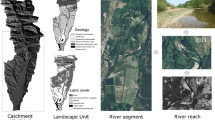Abstract
Land use change and other human disturbances have significant impacts on physicochemical and biological conditions of stream systems. Meanwhile, linking these disturbances with hydrology and water quality conditions is challenged due to the lack of high-resolution datasets and the selection of modeling techniques that can adequately deal with the complex and nonlinear relationships of natural systems. This study addresses the above concerns by employing a watershed model to obtain stream flow and water quality data and fill a critical gap in data collection. The data were then used to estimate fish index of biological integrity (IBI) within the Saginaw Bay basin in Michigan. Three methods were used in connecting hydrology and water quality variables to fish measures including stepwise linear regression, partial least squares regression, and fuzzy logic. The IBI predictive model developed using fuzzy logic showed the best performance with the R 2 = 0.48. The variables that identified as most correlated to IBI were average annual flow, average annual organic phosphorus, average seasonal nitrite, average seasonal nitrate, and stream gradient. Next, the predictions were extended to pre-settlement (mid-1800s) land use and climate conditions. Results showed overall significantly higher IBI scores under the pre-settlement land use scenario for the entire watershed. However, at the fish sampling locations, there was no significant difference in IBI. Results also showed that including historical climate data have strong influences on stream flow and water quality measures that interactively affect stream health; therefore, should be considered in developing baseline ecological conditions.








Similar content being viewed by others
References
Adriaenssens V, De Baets B, Goethals PLM, De Pauw N (2004) Fuzzy rule-based models for decision-support in ecosystem management. Sci Total Environ 319:1–12
Adriaenssens V, De Baets B, Goethals PLM, De Pauw N (2006) Fuzzy knowledge-based models for prediction of Asellus and Gammarus in watercourses in Flanders (Belgium). Ecol Model 195:3–10
Barbour MT, Gerritsen J, Snyder BD, Stribling JB (1999) Rapid bioassessment protocols for use in streams and wadeable rivers: periphyton, benthic macroinvertebrates and fish, second edition. EPA 841-B-99-002. U.S. Environmental Protection Agency, Office of Water, Washington, DC
BASINS (2007) Better Assessment Science Integrating Point and Nonpoint Sources. U.S. Environmental Protection Agency, Washington, DC. http://www.epa.gov/waterscience/basins. Accessed 10 Aug 2011
Bernot MJ, Tank JL, Royer TV, David MB (2006) Nutrient uptake in streams draining agricultural catchments of the midwestern United States. Freshw Biol 51:499–509
Box GEP, Cox DR (1964) An analysis of transformations. J R Stat Soc B 26:211–252
Brenden T, Wang L, Su Z (2008) Quantitative identification of disturbance thresholds in support of aquatic resource management. Environ Manag 42:821–832
Caissie D (2006) The thermal regime of rivers: a review. Freshw Biol 51:1389–1406
Carrascal LM, Galván I, Gordo O (2009) Partial least squares regression as an alternative to current regression methods used in ecology. Oikos 118:681–690
Chen QW, Mynett AE (2003) Integration of data mining techniques and heuristic knowledge in fuzzy logic modelling of eutrophication in Taihu Lake. Ecol Model 162(1–2):55–67
Comer PJ, Albert DA, Wells HA, Hart BL, Raab JB, Price DL, Kashian DM, Comer RA, Schuen DW, Austin MB, Leibfried TR, Korroch KM, Prange-Gregory L, Spitzley JG, DeLain CJ, Scrimger LJ (1995) Michigan’s presettlement vegetation, as interpreted from the General Land Office surveys 1816–1856. Michigan Natural Features Inventory, Lansing
Dale VH (1997) The relationship between land-use change and climate change. Ecol Appl 7(3):753–769
Dale VH, Polasky S (2007) Measures of the effects of agricultural practices on ecosystem services. Ecol Econ 64:286–296
Flinders C, Horwitz R, Belton T (2008) Relationship of fish and macroinvertebrate communities in the mid-Atlantic uplands: implications for integrated assessments. Ecol Indic 8:588–598
Fowler HJ, Blenkinsop S, Tebaldi C (2007) Linking climate change modelling to impacts studies: recent advances in downscaling techniques for hydrological modelling. Int J Climatol 27(12):1547–1578
Gilliom RJ (2007) Pesticides in U.S. streams and groundwater. Environ Sci Technol 41:3409–3414
Harding JS, Benfield EF, Bolstad PV, Helfman GS, Jones EBD (1998) Stream biodiversity: the ghost of land use past. Proc Natl Acad Sci USA 95:14843–14847
Hoar T, Nychka D (2008) Statistical downscaling of the Community Climate System Model (CCSM) monthly temperature and precipitation projections. White Paper. Boulder
Huang YB, Lan YB, Thomson SJ, Fangc A, Hoffmannb WC, Laceyd RE (2010) Development of soft computing and applications in agricultural and biological engineering. Comput Electron Agric 71:107–127
Infante D, Allan D, Linke S, Norris RH (2008) Relationship of fish and macroinvertebrate assemblages to environmental factors: implications for community concordance. Hydrobiologia 623:87–103
Johnson DM, Mueller R (2010) The 2009 Cropland Data Layer. http://www.nass.usda.gov/research/Cropland/docs/JohnsonPE&RS_Nov2010.pdf. Accessed 10 Aug 2011
Karr J (1991) Biological Integrity: a long-neglected aspect of water resources management. Ecol Appl 1(1):66–84
Karr JR, Dudley DR (1981) Ecological perspective on water quality goals. Environ Manag 5:55–68
Karr JR, Fausch KD, Angermeier PL, Yant PR (1986) Assessing biological integrity in running waters: a method and its rationale. Spec. Pub 5. Illinois Natural History Survey 28, Champaign
Lammert M, Allan D (1999) Assessing biotic integrity of streams: effects of scale in measuring the influence of land use/cover and habitat structure on fish and macroinvertebrates. Environ Manag 23(2):257–270
Love BJ, Nejadhashemi AP (2011) Environmental impact analysis of biofuel crops expansion in the Saginaw River watershed. J Biobased Mater Bioenergy 5:1–25
Lyons J (1992) Using the index of biotic integrity (IBI) to measure environmental quality in warmwater streams of Wisconsin. General Technical Report NC-149. U.S. Department of Agriculture, Forest Service, North Central Experiment Station, St. Paul
Lyons J, Wang L, Simonson TD (1996) Development and validation of an index of biotic integrity for cold-water streams in Wisconsin. N Am J Fish Manag 16:241–256
Lyons J, Piette RR, Niermeyer KW (2001) Development, validation, and application of a fish-based index of biotic integrity for Wisconsin’s large warmwater rivers. Trans Am Fish Soc 130:1077–1094
Mahmood Z, Khan S (2009) On the use of k-fold cross-validation to choose cutoff values and assess the performance of predictive models in stepwise regression. Biostatistics 5(1):25
Mamdani EH (1977) Application of fuzzy logic to approximate reasoning using linguistic systems. IEEE Trans Comput 26:1182–1191
Marchini A (2011) Modelling ecological processes with fuzzy logic approaches. Model Complex Ecol Dyn 2 133–145. doi:10.1007/978-3-642-05029-9_10
Maret T, Konrad C, Tranmer A (2010) Influence of environmental factors on biotic responses to nutrient enrichment in agricultural streams. J Am Water Resour Assoc 46(3):498–513
Meyer JL (1997) Stream Health: incorporating the human dimension to advance stream ecology. J N Am Benthol Soc 16(2):439–447
Moriasi DN, Arnold JG, Van Liew MW, Binger RL, Harmel RD, Veith V (2007) Model evaluation guidelines for systematic quantification of accuracy in watershed simulations. Trans ASABE 50(3):885–900
Morris J, Mansfield E, Sherman J (1986) Failures to detect moderate effects with ordinary least squares-moderated multiple regression: some reasons and a remedy. Psychol Bull 99(2):282–288
Mouton A, Schneider M, Peter A, Holzer G, Muller R, Goethals P, De Pauw N (2008) Optimization of a fuzzy physical habitat model for spawning European grayling (Thymallus thymallus L.) in the Aare River (Thun, Switzerland). Ecol Model 215:122–132
Neitsch SL, Arnold JG, Kiniry JR, Williams JR (2005) Soil and water assessment tool theoretical documentation, version 2005. USDA-ARS Grassland, Soil and Water Research Laboratory, Temple. http://www.brc.tamus.edu/swat/doc.html. Accessed 10 Aug 2011
Poff NL, Zimmerman JKH (2010) Ecological responses to altered flow regimes: a literature review to inform the science and management of environmental flows. Freshw Biol 55:194–205
Pool TK, Olden JD, Whittier JB, Paukert CP (2010) Environmental drivers of fish functional diversity and composition in the Lower Colorado River Basin. Can J Fish Aquat Sci 67(11):1791–1807
Poole G, Berman C (2001) An ecological perspective on in-stream temperature: natural heat dynamics and mechanisms of human-caused thermal degradation. Environ Manag 27(6):787–802
R Development Core Team (2008) R: a language and environment for statistical computing. R Foundation for Statistical Computing, Vienna. http://www.R-project.org. Accessed 5 March 2012
Roth N, Allan D, Erickson DL (1996) Landscape influences on stream biotic integrity assessed at multiple spatial scales. Lansc Ecol 11(3):141–156
Rowe D, Pierce C, Wilton TF (2009) Physical habitat and fish assemblage relationships with landscape variables at multiple spatial scales in wadeable Iowa streams. N Am J Fish Manag 29:1333–1351
SAS/STAT (2010) SAS/STAT 9.2 User’s Guide, 2nd ed. http://support.sas.com/documentation/cdl/en/statug/63033/HTML/default/viewer.htm#statug_transreg_sect015.htm. Accessed 15 May 2012
Schneider JC (1997) GLEAS Procedure #51 Survey protocols for wadable rivers. Chapter 25A in (ed.) 2000. Manual of fisheries survey methods II: with periodic updates. Fisheries Special Report 25. Michigan Department of Natural Resources, Ann Arbor
Seelbach PW, Wiley MJ (1997) Overview of the Michigan Rivers Inventory project. Fish Division Technical Report 97-3. Michigan Department of Natural Resources, Ann Arbor
Shields FD, Knight SS Jr, Cooper CM (1995) Use of the index of biotic integrity to assess physical habitat degradation in warmwater streams. Hydrobiologia 312(3):191–208
Shields FD, Langendoen E, Doyle MW (2006) Adapting existing models to examine effects of agricultural conservation programs on stream habitat quality. J Am Water Resour Assoc 42(1):25–33
STATSoft (2011) STATISTICA. Statsoft® Inc., Tulsa
Sutela T, Vehanen T, Jounela P (2010) Response of fish assemblages to water quality in boreal rivers. Hydrobiologia 641:1–10
Trautman MB (1981) The fishes of Ohio. Ohio State University Press, Columbus
USDA (1995) State Soil Geographic (STATSGO) data base. http://www.nrcs.usda.gov/technical/techtools/statsgo_db.pdf. Accessed 10 Aug 2011
USEPA (2011) Great Lakes areas of concerns. Saginaw River and bay area of concern. http://www.epa.gov/grtlakes/aoc/sagrivr.html. Accessed 10 Aug 2011
van Griensven A, Meixner T, Grunwald S, Bishop T, Di Luzio M, Srinivasan R (2006) A global sensitivity analysis tool for the parameters of multi-variable catchment models. J Hydrol 324(1–4):10–23
Van Sickle J, Baker J, Herlihy A, Bayley P, Gregory S, Haggerty P, Ashkenas L, Li J (2004) Projecting the biological condition of streams under alternative scenarios of human land use. Ecol Appl 14:368–380
Vannote RL, Minshall GW, Cummins KW, Sedell JR, Cushing CE (1980) The river continuum concept. Can J Fish Aquat Sci 37:130–137
Waite I, Brown L, Kennen J, May J, Cuffney T, Orlando J, Jones K (2010) Comparison of watershed disturbance predictive models for stream benthic macroinvertebrates for three distinct ecoregions in western US. Ecol Indic 10(6):1125–1136
Wang L, Seelbach PW, Lyons J (2006) Effects of levels of human disturbance on the influence of catchment, riparian, and reach-scale factors on fish assemblages. Am Fish Soc Symp 48:199–219
Wang L, Robertson DM, Garrison PJ (2007) Linkages between nutrients and assemblages of macroinvertebrates and fish in wadeable streams: implication to nutrient criteria development. Environ Manag 39:194–212
Wang L, Brenden T, Seelbach PW, Cooper A, Allan D, Clark RJ, Wiley M (2008) Landscape based identification of human disturbance gradients and references for streams in Michigan. Environ Monit Assess 141:1–17
Webb BW, Hannah DM, Moore RD, Brown LE, Nobilis F (2008) Recent advantages in stream and river temperature research. Hydrol Process 22:902–918
Weigel BM, Robertson DM (2007) Identifying biotic integrity and water chemistry relations in nonwadeable rivers of Wisconsin: toward the development of nutrient criteria. Environ Manag 40:691–708
Woznicki SA, Nejadhashemi AP, Smith C (2011) Assessing best management practice implementation strategies under climate change scenarios. Trans ASABE 54(1):171–190
Zadeh LA (1965) Fuzzy sets. Inf Control 8(3):338–353
Zimmerman J, Vondracek B, Westra J (2003) Agricultural land use effects on sediment loading and fish assemblages in two Minnesota (USA) watersheds. Environ Manag 32(1):93–105
Acknowledgments
The authors would like to thank Ms. Minako Edgar at the Institute for Fisheries Research for her assistance in preparing GIS layers, Dr. Sasha Kravchenko and Juan David Munoz at Michigan States Department of Crop and Soil Science for their assistance with statistical analysis. Support was provided by The Nature Conservancy’s Great Lakes Fund for Partnership in Conservation Science and Economics. Funding for this project was provided by a Grant from the US Department of Agriculture, Natural Resources Conservation Service agreement number 68-3A75-8-86.
Author information
Authors and Affiliations
Corresponding author
Electronic supplementary material
Below is the link to the electronic supplementary material.
Rights and permissions
About this article
Cite this article
Einheuser, M.D., Nejadhashemi, A.P., Wang, L. et al. Linking Biological Integrity and Watershed Models to Assess the Impacts of Historical Land Use and Climate Changes on Stream Health. Environmental Management 51, 1147–1163 (2013). https://doi.org/10.1007/s00267-013-0043-7
Received:
Accepted:
Published:
Issue Date:
DOI: https://doi.org/10.1007/s00267-013-0043-7




